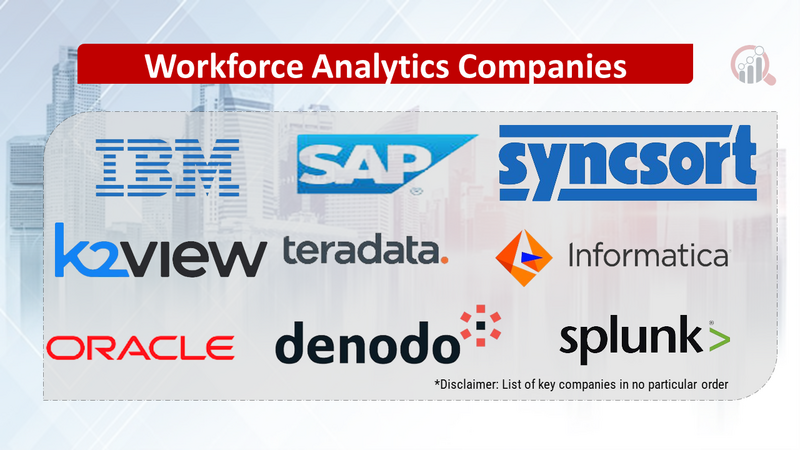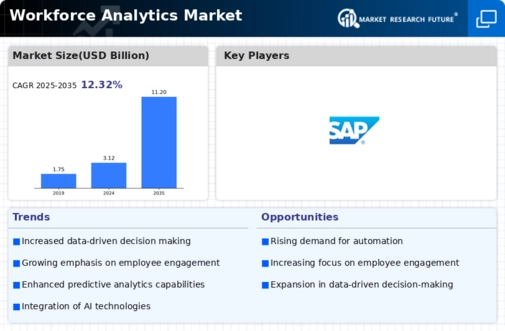Top Industry Leaders in the Workforce Analytics Market

Workforce Analytics Market: Dive into the Latest News and Updates
In today's competitive talent landscape, organizations understand the critical role their workforce plays in achieving success. This has fueled the meteoric rise of Workforce Analytics (WFA), a data-driven approach to optimizing staffing, performance, and overall employee experience.
Some of Workforce Analytics Companies Listed Below:
- SAP SE(Germany)
- Informatica (U.S.)
- Splunk Inc. (U.S.)
- Denodo (U.S.)
- Syncsort Inc. (U.S.)
- IBM Corporation(U.S.)
- Oracle Corporation(U.S.)
- Global DS (U.S.)
- Teradata Corporation (U.S.)
- K2 View (U.S.)
Strategies Fueling Growth:
-
Focus on Specific Use Cases: Developing tailored WFA solutions for talent acquisition, performance management, employee engagement, or workforce planning addresses specific organizational challenges and attracts targeted clientele. -
Cloud-Based Deployment and Ease of Use: Offering cloud-based WFA platforms with intuitive interfaces simplifies deployment, lowers upfront costs, and ensures user-friendliness for HR teams. -
Integration with Existing HR Systems: WFA solutions that seamlessly integrate with existing HR software and data sources optimize data usage, streamline workflows, and enhance adoption among HR professionals. -
Emphasis on AI and Machine Learning: Integrating AI and ML for predictive analytics, talent forecasting, and automated employee insights generates actionable intelligence for improved decision-making.
Market Share Decoding: Key Factors to Consider:
-
Functionality and Feature Set: WFA platforms offering diverse modules, comprehensive data analysis capabilities, and pre-built dashboards for various use cases cater to broader needs and attract larger customer bases. -
Industry Expertise and Vertical Focus: Platforms with deep understanding of specific industries and their HR challenges can tailor solutions for optimal workforce management within those sectors, gaining an edge in niche markets. -
Data Security and Privacy Compliance: Robust data security features, adherence to privacy regulations, and transparency in data handling build trust and ensure ethical implementation of WFA solutions. -
Scalability and Flexibility: WFA platforms offering flexible deployment options, easy customization, and the ability to handle large data volumes adapt to diverse organizational needs and future growth.
New and Emerging Stars: Illuminating the WFA Path:
-
Hyper-Automation and Robotic Process Automation (RPA): Startups like UiPath and Automation Anywhere are integrating RPA within WFA platforms, automating repetitive HR tasks and streamlining administrative processes. -
Employee Sentiment and Experience Analytics: Companies like Qualtrics and Medallia are developing tools for analyzing employee sentiment through surveys, social media, and sentiment analysis, providing insights for improving employee engagement and retention. -
Predictive Talent Analytics and Workforce Planning: Startups like PredictiveHire and Glint utilize AI and machine learning to predict talent needs, forecast labor shortages, and optimize workforce planning for improved talent management.
Investment Trends: Where the WFA Dollars Flow:
-
Cloud-Based WFA Platforms: Investors are backing companies developing agile and scalable cloud-based WFA platforms for their ease of deployment, lower costs, and faster access to insights. -
AI-Powered Analytics and Automation: Startups leveraging AI for advanced workforce analytics, automated insights extraction, and predictive talent solutions attract significant investment for their potential to revolutionize HR decision-making.
Latest Company Updates:
-
Scheduled Emails: Administrators can now schedule standard and custom reports to be sent by email on a regular basis. This feature allows team members to receive periodic updates about reports, including data for the specified date range with any filters or comparisons applied at the time of scheduling. (May 6, 2024) -
Increased Parameter Value Character Limit for GA4 360 Customers: Google Analytics 360 customers with Google Analytics 4 properties can now send string parameter values of up to 500 characters from web data streams. Previously, Analytics 360 GA4 properties would truncate string parameter values that exceed the 100 character limit. This update provides greater flexibility in collecting URL and UTM combinations, campaign names, product bundle names, and other custom and predefined values. (May 13, 2024) -
ADP Employment Report: The ADP Research Institute collaborates with the Stanford Digital Economy Lab and its team of labor market researchers to publish employment reports. These reports provide insights into the current state of employment. (May 20, 2024) -
Google Analytics 4: Google Analytics 4 is designed with privacy at its core, offering more comprehensive and granular controls for data collection and usage. It no longer stores IP addresses and provides solutions and controls to meet evolving privacy needs and user expectations. Google Analytics 4 helps businesses understand their customers across touchpoints and supports key objectives such as driving sales, generating leads, and connecting online and offline customer engagement. It is recommended to upgrade to Google Analytics 4 before July 1, as Universal Analytics will sunset soon. (May 27, 2024)

